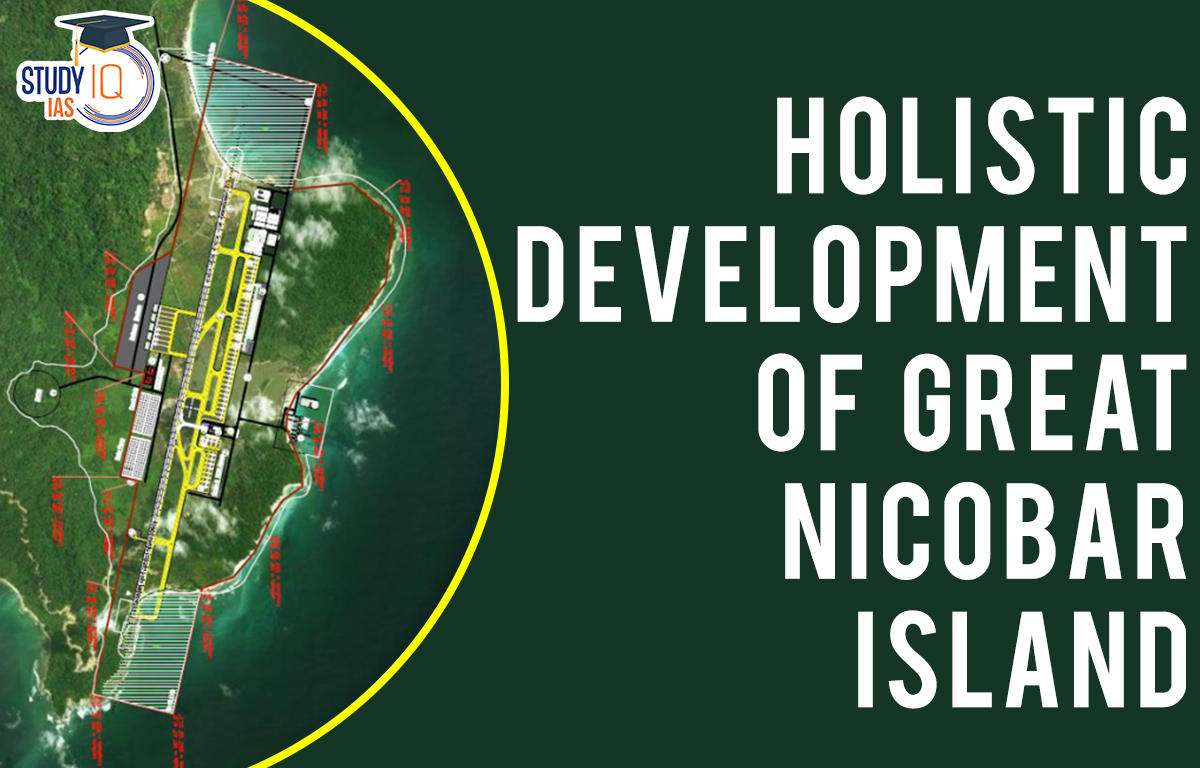Table of Contents
Context: The Union Ministry of Environment, Forest and Climate Change (MoEFCC) has cleared the decks for the ‘Holistic Development of Great Nicobar Island’ mega project at the cost of about Rs 70,000 crore at the southern tip of the Andaman and Nicobar Islands.
About the Holistic Development of Great Nicobar Island
- NITI Aayog is piloting the ‘Holistic Development of Great Nicobar Island’ project and the Andaman and Nicobar Islands Integrated Development Corporation is the project proponent.
- The project aims to develop:
- An international transhipment port of 14.2 mTEU cargo capacity at Galathea Bay along the island’s south-eastern coast;
- An international airport to support 4,000 passengers during peak hours, a 450 MVA gas and solar-based power plant;
- An ecotourism and residential township of about 160 sq km.

Purpose of the Project
- Leverage strategic location: The government wants to leverage the locational advantage of the island for economic and strategic reasons.
- Great Nicobar is located equidistant from Colombo to the southwest and Port Klang and Singapore to the southeast, and is close to the East-West international shipping corridor, through which a very large part of the world’s shipping trade passes.
- The proposed ICTT has potential to become a hub for cargo ships travelling on this route.
- Security aspects: The project is critical for security and consolidation of the Indian Ocean Region. Increasing Chinese assertion in the Bay of Bengal and the Indo-Pacific has added great urgency for this development project.

Concerns Regarding the Project
- Quick clearances: The process towards implementation of this free trade zone and transhipment facility in Great Nicobar started in September 2020 when the NITI Aayog issued a request for proposals for preparing the master plan for the project.
- The quick approvals, clearances, exemptions and de-notifications show that the Union government is keen to implement this project without taking all stakeholders into account.
- Ecological and environmental cost: The Island, which is spread over 900 sq km, was declared a biosphere reserve in 1989 and included in the UNESCO’s Man and Biosphere Programme in 2013.
- The project will end up destroying vast stretches of coral reefs. The EIA report recommends ‘translocation’ of these organisms which are facing climate change-induced ocean warming.
- Transplanted corals do not have a high survival rate and are susceptible to bleaching.
- Violates rights of indigenous tribes: More than three-fourth of the island is designated as a tribal reserve.
- This project will run counter to the rights of vulnerable tribal communities, such as the Nicobarese and Shompen.
- Cosmetic cover-up: The EIA report states that compensatory afforestation will be carried out in Haryana and Madhya Pradesh. The ecological comparison of these states to Great Nicobar is farcical.
- Vulnerability to disaster: The EIA report admits that the Great Nicobar lies in close proximity to the Ring of Fire. It is prone to severe natural disasters.
- Lack of scientific studies: The EIA report does not mention any scientific studies conducted during and prior to the 2004 Tsunami.
- The coastline of the Great Nicobar Islands, which was raised earlier, sank several meters during the earthquake.
- This makes the Great Nicobar Island unsuitable to be developed as an urban port city.
Great Nicobar Island
- The Great Nicobar is located at the southernmost part of the Andaman and Nicobar Islands. Andaman and Nicobar Islands are separated by the 150-km wide Ten Degree Channel.
- The Andaman Islands are located to the north of the channel, and the Nicobar Islands to the south.
- Indira Point on the southern tip of Great Nicobar Island is India’s southernmost point. It is located less than 150 km from the northernmost island of the Indonesian archipelago.
- Aboriginal groups: Shompen and Nicobarese tribal peoples are the aboriginal groups. The Shompen are hunter-gatherers who depend on forest and marine resources for living. The Nicobarese lived along the west coast of the island, but are now relocated.
- Flora and fauna: The Great Nicobar Island has tropical wet evergreen forests, mountain ranges and coastal plains.
- The leatherback sea turtle is the flagship species of the island.



 Editorial of the Day (14th May): Impact ...
Editorial of the Day (14th May): Impact ...
 Smart Cities Mission (SCM), Objectives, ...
Smart Cities Mission (SCM), Objectives, ...
 DigiLocker, Features, Use Cases and Lega...
DigiLocker, Features, Use Cases and Lega...

















